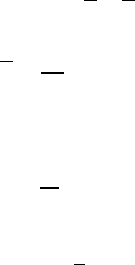Galdi G.P. An Introduction to the Mathematical Theory of the Navier-Stokes Equations: Steady-State Problems
Подождите немного. Документ загружается.


806 XII Two-Dimensional Flow in Exterior Domains
Z
Ω
ρ
h∆ψ
R
≤
c
R
2
Z
Ω
ρ
ω
2
≤
c
R
2
|v|
2
1,2
Z
Ω
ρ
hv · ∇ψ
R
≤ 2ω
0
Z
Ω
ρ
|ω||v · ∇ψ
R
| ≤ 2ω
0
kωk
2,Ω
ρ
kv · ∇ψ
R
k
2,Ω
ρ
≤ c
1
ω
0
(ln l n R)
−1/2
|v|
1,2
.
(XII.3.6 )
Furthermore,
Z
Ω
ρ
ψ
R
f
y
∂h
0
∂x
−f
x
∂h
0
∂y
≤
1
2
Z
Ω
ρ
|ψ
R
h
00
|(|∇ω|
2
+ |f|
2
) (XII.3.7)
and so, collecting (XII.3.3) and (XII .3.5)–(XI I.3.6) we obtain
Z
{Ω
ρ
;|ω|≤ω
0
}
ψ
R
|∇ω|
2
≤
1
2
Z
∂B
ρ
∂ω
2
∂n
−v ·nω
2
+ c
2
|v|
1,2
[|v|
1,2
R
−2
+ ω
0
(ln l n R)
−1/2
]
+ c
3
kf k
2
2,Ω
ρ
+
Z
Ω
ρ
|h
0
||∇ψ
R
||f|
.
We then let R → ∞ into this relation and use the monotone convergence
criterion along with the assumptio n on f to deduce, for some positive constant
c
4
independent of ω
0
,
Z
{Ω
ρ
;|ω|≤ω
0
}
|∇ω|
2
≤ c
4
which, by the arbitrarity o f ω
0
, implies ∇ω ∈ L
2
(Ω
ρ
). Having established this,
we come back to (XII.3.5) and let R → ∞ and then ω
0
→ ∞, which compl etes
the proof. ut
An im mediate consequence o f the result just shown is the following theo-
rem of the Liouville type.
Theorem XII.3.1 Let v be a D-solution to (XII.0.1) in the whole of R
2
corresponding to f ≡ 0. Then v ≡ const.
Proof. From Lemma XII. 3.1 it follows that ω = const. and then, from
(XII.3.2 ), ∆v = 0 in R
2
. Since v ∈ D
1,2
(R
2
), by Exercise II.11.11, we find
v ≡ const. and the proof is complete. ut
The next objective is to find a po intwise estimate on v. To this end, we
propose the following
Lemma XII.3.2 Let v and f be as in Lemma XII.3.1. Then,
v ∈ D
1,q
(Ω
ρ
) for all q ∈ [2, ∞).

XII.3 On the Asymptotic Behavior of D-Solutions 807
Proof. By (XII.3.2) and by Lemma XII.3.1 we have
∆v ∈ L
2
(Ω
ρ
)
and so, from the scalar version of Theorem V.5.3 (cf. Remark V.5.3), we deduce
v ∈ D
2,2
(Ω
ρ
),
which implies
∇v ∈ W
1,2
(Ω
ρ
).
The result is then a consequence of thi s latter property and the embedding
Theorem II.3.4.
ut
From the result j ust shown we obtained the desired pointwise bound on
v. Specifically, we have the following lemma.
Lemma XII.3.3 Let v and f be as in Lemma XII.3.2. Then
lim
|x|→∞
|v(x)|/
p
log |x|
= 0 uniformly.
Proof. It is an immediate consequence o f Lemma XII.3.2 and Theorem I I.9.1.
ut
Concerning the summability of higher-order derivatives, we can prove the
following result.
Lemma XII.3.4 Let v be as in Lemma XII.3.1. If for some ρ > δ(Ω
c
) and
m ≥ 0,
f ∈ W
m,2
(Ω
ρ
),
then we have
D
2
v ∈ W
m,2
(Ω
ρ
).
Proof. The result is already known from Lemma XII.3.2 if m = 0. Let us
begin to prove it for m = 1. We op erate with D
k
on both sides of (XII.3.1) to
obtain
∆ω
k
= v · ∇ω
k
+ D
k
v ·∇ω + F
k
(XII.3.8 )
with
ω
k
= D
k
ω
F
k
= D
k
∂f
x
∂y
−
∂f
y
∂x
.

808 XII Two-Dimensional Flow in Exterior Domains
Multiplying both si des of (XII.3.8) by ψ
R
ω
k
, with ψ
R
chosen as in Lemma
XII.3.1, and integrating by parts over Ω
ρ
yields
Z
Ω
ρ
ψ
R
|∇ω
k
|
2
=
1
2
Z
Ω
ρ
ω
2
k
(∆ψ
R
+ v · ∇ψ
R
) + 2ψ
R
ω
k
D
k
v · ∇ω
+
Z
Ω
ρ
ψ
R
ω
k
F
k
+ B
ρ
.
(XII.3.9 )
In (XII.3.9), as in the remaining part of the proof, we denote by B
ρ
the
generic contribution of boundary integrals over ∂B
ρ
, whose explicit value is
not important to our purposes. By the prop erties of ψ
R
and Lemma XII.3.3
we have
|∆ψ
R
+ v · ∇ψ
R
| ≤ c
1
/R. (XII.3.10)
We also have
Z
Ω
ρ
ψ
R
ω
k
F
k
≤
1
2
Z
Ω
ρ
ψ
R
|∇ω
k
|
2
+ c
2
|ω|
2
1,2
+ |f |
2
1,2
. (XII.3.11)
Moreover, using ∇ · v = 0, we find
ψ
R
ω
k
D
k
v ·∇ω =
1
2
D
k
[ψ
R
D
k
v · ∇ω
2
] − ∇ · [
1
2
ψ
R
ω
2
D
2
k
v]
+ω
2
∇ψ
R
· D
2
k
v −
1
2
D
k
ψ
R
D
k
v · ∇ω
2
−ψ
R
ωD
k
v · ∇ω
k
and so we deduce that
Z
Ω
ρ
ψ
R
ω
k
D
k
v · ∇ω
≤ c
3
|v|
2,2
|v|
2
1,4
+
1
4
Z
Ω
ρ
ψ
R
|∇ω
k
|
2
+ |v|
2
1,4
+ B
ρ
.
In view of Lemma XII.3. 2, we may conclude, for a constant c
4
independent of
R, that
Z
Ω
ρ
ψ
R
ω
k
D
k
v ·∇ω
≤ c
4
+
1
4
Z
Ω
ρ
ψ
R
|∇ω
k
|
2
. (XII.3.12)
Replacing (XII.3. 10)–(XII.3.12) in (XII.3.9) furnishes
Z
Ω
ρ
ψ
R
|∇ω
k
|
2
≤ c
5
with c
5
= c
5
(v, f). Thus, letting R → ∞ into this inequality, we deduce that
D
2
ω ∈ L
2
(Ω
ρ
). (XII.3 .13)
Recalling (XII.3.2) and that ∇ω ∈ L
2
(Ω
ρ
), from (XII.3.13), Lemma XII.3.2,
and R emark V.5.3 we infer that
XII.3 On the Asymptotic Behavior of D-Solutions 809
D
2
v ∈ W
1,2
(Ω
ρ
), (XII. 3.14)
which proves the lemma in the case where m = 1. It is now easy to extend
the result to arbitrary m > 1. Actually, by (XII.3.14), Theorem II.3.4, and
Lemma XII.3.2 we have
D
2
v ∈ L
q
(Ω
ρ
) f or all q ∈ [2, ∞)
∇v ∈ L
∞
(Ω
ρ
).
(XII.3.1 5)
Differentiating (XII.3.8) one more time we find that
∆ω
sk
= v · ∇ω
sk
+ D
s
v · ∇ω
k
+ D
k
v · ∇ω
s
+ D
s
D
k
v ·∇ω + F
sk
≡ v · ∇ω
sk
+ F
sk
+ F
sk
(XII.3.1 6)
with
ω
sk
= D
s
ω
k
F
sk
= D
s
F
k
.
We multiply both sides of (XII.3.16) by ψ
R
ω
sk
and integrate over Ω
ρ
. Then
we treat the term
Z
Ω
ρ
ψ
R
ω
sk
v ·∇ω
ks
as we did for the analogo us term in the case where m = 1. On the other hand,
making use of (XII.3.15) we can show directly (without integration by parts)
that
Z
Ω
ρ
F
sk
ω
sk
≤ c
6
,
with c
6
= c
6
(v, f). We then conclude that
∇ω
sk
∈ L
2
(Ω
ρ
);
reasoning as before we obtain
D
2
v ∈ W
2,2
(Ω
ρ
).
Then, by Theorem II.3.4, it follows that
D
3
v ∈ L
q
(Ω
ρ
) f or all q ∈ [2, ∞)
D
2
v ∈ L
∞
(Ω
ρ
).
Iterating such a procedure as many times as needed, we then complete the
proof of the lemma. ut
We are now in a position to show a first result on the poi ntwise convergence
on the derivatives of v and p.

810 XII Two-Dimensional Flow in Exterior Domains
Theorem XII.3.2 Let v be a D-solution to (XII.0.1). If for some ρ > δ(Ω
c
)
and some m ≥ 1
f ∈ W
m,2
(Ω
ρ
),
then we have
(i) lim
|x|→∞
|D
α
v(x)| = 0 uniformly, 1 ≤ |α| ≤ m.
If, in addition,
f ∈ W
m+1,q
(Ω
ρ
), some q ∈ (1, 2),
we also have
(ii) lim
|x|→∞
|D
α
p(x)| = 0 uniformly, 1 ≤ |α| ≤ m.
Proof. Let v
α
≡ D
α
v. By assumption and Lemma XII.3.4, we have
v
α
∈ W
2,2
(Ω
ρ
), 1 ≤ |α| ≤ m.
Thus, by the embedding Theorem II.3.4, it follows that
v
α
∈ W
1,r
(Ω
ρ
), for all r ∈ [2, ∞),
so that (i) becomes a consequence of Theorem II.9.1. To show (ii), we observe
that, tak ing the divergence of both sides of (XII.0.1)
1
we can deduce that
∆p = 2
∂v
x
∂x
∂v
y
∂y
−
∂v
x
∂y
∂v
y
∂x
+ ∇ · f . (XII.3.17)
By hypothesis and Lemma XII.3.2, it follows that
∆p ∈ L
q
(Ω
ρ
), (XII.3.18)
where q is specified in the statement of the theorem. Moreover, since by
(XII.0.1 )
∂p
∂x
=
∂ω
∂y
−v
x
∂v
x
∂x
−v
y
∂v
x
∂y
+ f
x
∂p
∂y
= −
∂ω
∂x
− v
x
∂v
y
∂x
− v
y
∂v
y
∂y
+ f
y
(XII.3.1 9)
with the help of Lemma XII .3.1 and Lemma XII.3.3, we immediately obtain
Z
Ω
ρ
|∇p|
2
log |x|
< ∞ (XII.3.20 )
and so, from (XII. 3.18), (XII. 3.20) we may assert (cf. Exercise XII.3.1)
D
2
p ∈ L
q
(Ω
ρ
). (XII. 3.21)

XII.3 On the Asymptotic Behavior of D-Solutions 811
Since q < 2, we apply Theorem II.6.1 to ∇p to deduce the existence of a
constant p
1
such that
∇p − p
1
∈ L
s
(Ω
ρ
), s = 2q/(2 −q),
lim
|x|→∞
Z
S
2
|∇p(x) − p
1
| = 0.
(XII.3.2 2)
However, because of (XII.3.20), we must have p
1
= 0, a nd (XII.3.22) im plies
∇p ∈ L
s
(Ω
ρ
), s = 2q/(2 −q). (XII.3.23)
Operating with D
α
, 1 ≤ |α| ≤ m, on both sides of (XII.3.17) and using the
results of Lemma XII. 3.2 and Lemma XII. 3.4, we obtain
∆p ∈ W
m,q
(Ω
ρ
).
This latter property together, with (XII.3 .23) and Remark V.5.3, allows us to
infer that
D
2
p ∈ W
m,q
(Ω
ρ
). (XII.3.24)
By (XII.3.24) and the embedding Theorem II.3.4 we recover (at least)
D
α
p ∈ L
s
(Ω
ρ
) ∩ D
1,q
(Ω
ρ
), 1 ≤ |α| ≤ m, (XII.3 .25)
with s given in (XII.3.23). From (XII.3.23), (XII. 3.25), and Theorem II.9.1
we then obtain the pointwise convergence (ii). The theorem is proved. ut
Exercise XII.3.1 Let p be a smooth field satisfying (XII.3.18) and (XII.3.20) for
some q ∈ ( 1, ∞). Show that p obeys (XII.3.21). Hint: Let π = ϕp where ϕ is a
“cut-off” function that is zero in Ω
ρ
and one in Ω
2ρ
. Derive the equation for π in
the whole of R
2
, and use the results of Exercise II.11.9 and Exercise II.11.11.
We shal l now draw attention to the behavior at infinity of v and p. We
begin to show that the pressure p ha s a pointwise limit at infinity. This will
be achieved through a number of intermediate results due to Gilbarg & Wein-
berger (1978, §4), which we are now going to derive. For a given (vector or
scalar) f unction f in Ω we denote by f = f(r) its average over the unit circle,
that is,
f =
1
2π
Z
2π
0
f(r, θ)dθ.
Lemma XII.3.5 Let v be a D-solution to (XII.0.1). If for some ρ > δ(Ω
c
)
f
r
r
∈ L
1
(Ω
ρ
),
then there is a p
0
∈ R such that
lim
r→∞
p(r) = p
0
.

812 XII Two-Dimensional Flow in Exterior Domains
Proof. Multiplyi ng (XII.3.19)
1
by cos θ and (XII.3.19)
2
by sin θ, adding up,
and using (0.1
2
), we find
∂p
∂r
=
1
r
∂ω
∂θ
+ v
x
∂v
y
∂θ
−v
y
∂v
x
∂θ
+ f
r
. (XII. 3.26)
Integrating this equation from 0 to 2π, dividing by 2π, and observing that
Z
2π
0
v
x
∂v
y
∂θ
dθ =
Z
2π
0
v
y
∂v
x
∂θ
dθ = 0,
we deduce tha t
∂p
∂r
=
1
2πr
Z
2π
0
(v
x
− v
x
)
∂v
y
∂θ
− (v
y
− v
y
)
∂v
x
∂θ
dθ + f
r
and so, integrating from r
1
to r
2
, squaring, and applying the Schwarz inequal-
ity, it follows that
2π
2
|p(r
2
) −p(r
1
)|
2
≤
Z
r
2
r
1
Z
2π
0
|v −v|
2
r
drdθ
Z
r
2
r
1
Z
2π
0
1
r
∂v
∂θ
2
drdθ
+
Z
Ω
r
1
,r
2
f
r
r
!
2
.
(XII.3.2 7)
By the Wirtinger inequality (II.5 .17) and Exercise II.5.12,
Z
2π
0
|v − v|
2
dθ ≤
Z
2π
0
∂v
∂θ
2
dθ, (XII.3.28)
and since |∂v/∂θ| ≤ r|∇v|, from (XII.3.27) we recover
2π
2
|p(r
2
) − p(r
1
)|
2
≤ |v|
4
1,2,Ω
r
1
,r
2
+ kf
r
/rk
2
1,Ω
r
1
,r
2
.
The result is proved. ut
Lemma XII.3.6 Let v and f be as in Lemma XII.3.5. Then there exists a
sequence {R
k
} such that
R
k
∈ (2
2
k
, 2
2
k+1
)
lim
k→∞
Z
2π
0
|p(R
k
, θ) − p(R
k
)|
2
dθ = 0.
Proof. From the Wirtinger inequality (XII.3.28) applied to p and the integral
theorem of the mean, for each k ∈ N there is an R
k
, as stated in the lemma,
such that (with ρ
k
= 2
2
k
)

XII.3 On the Asymptotic Behavior of D-Solutions 813
log 2
Z
2π
0
|p(R
k
, θ) −p(R
k
)|
2
dθ =
Z
ρ
k+1
ρ
k
Z
2π
0
|p(r, θ) − p(r)|
2
r log r
dθdr
≤
Z
ρ
k+1
ρ
k
Z
2π
0
∂p
∂θ
2
(r log r)
−1
dθdr
≤
Z
Ω
ρ
k
,ρ
k+1
|∇p|
2
log |x|
.
The result then f ollows from this inequality and (XII.3.20).
ut
In the next lemma we shall prove that p converges strongly to some p
0
∈ R
in L
2
(S
1
). To this end, we need a particular representation of p −p in suitable
regions. Let {R
k
} be the sequence determined in the previous lemma and let
A
km
be the annulus
A
km
=
x ∈ R
2
: R
k
< |x| < R
m
, k < m.
It is well known that Green’s function (of the first kind) for the Laplace
operator in the domain A
km
is given by
G(r, θ; ρ, ϕ) =
∞
X
s=1
(r
s
−R
2s
k
/r
s
)(ρ
s
−R
2s
m
/ρ
s
)
2πs(R
2s
m
− R
2s
k
)
cos (s(θ − ϕ))
−
log(r/R
m
) log(R
k
/ρ)
2π log(R
k
/R
m
)
≡ G
1
+ G
2
, r < ρ,
(XII.3.2 9)
and with r and ρ interchang ed if r > ρ, cf. Weinberger (19 65, p.140, Prob-
lem 2 with answer on p.417 ). (The no tation (r, θ; ρ, ϕ) means the pair (x; y)
expressed i n polar coordinates.) Setting
Π = Π(ρ, θ) ≡ p(r, θ) − p(r),
and observing that for all r ∈ A
km
Z
2π
0
G
2
(r) ∆Π(r, θ)dθ =
Z
2π
0
∂G
2
(r)
∂r
Π(r, θ)dθ = 0,
from (III.1.33) we deduce the following representation for Π in A
km
Π(r, θ) =
Z
R
m
R
k
ρ
Z
2π
0
G
1
(r, θ; ρ, ϕ)∆Π(ρ, ϕ)dρdϕ
+
Z
2π
0
∂G
1
(r, θ; R
m
, ϕ)
∂ρ
Π(R
m
, ϕ)R
m
dϕ
−
Z
2π
0
∂G
1
(r, θ; R
k
, ϕ)
∂ρ
Π(R
k
, ϕ)R
k
dϕ.
(XII.3.3 0)
Formula (XII.3 .30) allows us to prove the following.

814 XII Two-Dimensional Flow in Exterior Domains
Lemma XII.3.7 Let v, f, and p
0
be as in Lemma XII.3.5. Assume, further,
that for some ρ > δ(Ω
c
)
f ∈ L
2
(Ω
ρ
), ∇ · f ∈ L
1
(Ω
ρ
).
Then
lim
r→∞
Z
2π
0
|p(r, θ) −p
0
|
2
= 0.
Proof. Squaring both sides of (XII.3.30) and integrating over θ from 0 to 2π,
we obtain
1
3
Z
2π
0
Π
2
(r, θ)dθ ≤ I
1
+ I
2
+ I
3
,
where
I
1
=
Z
R
m
R
k
dρ
1
Z
R
m
R
k
dρ
2
Z
2π
0
dϕ
1
Z
2π
0
dϕ
2
{∆Π(ρ
1
, ϕ
1
)∆Π(ρ
2
, ϕ
2
)
×[
Z
2π
0
G
1
(r, θ; ρ
1
, ϕ
1
)G
1
(r, θ; ρ
2
, ϕ
2
)dθ]}
I
2
= 2π
Z
2π
0
dθ
(
Z
2π
0
∂G
1
(r, θ; R
m
, ϕ)
∂ρ
2
R
2
m
dϕ
)
·
Z
2π
0
|Π(R
m
, ϕ)|
2
dϕ
I
3
= 2π
Z
2π
0
dθ
(
Z
2π
0
∂G
1
(r, θ; R
k
, ϕ)
∂ρ
2
R
2
k
dϕ
)
·
Z
2π
0
|Π(R
k
, ϕ)|
2
dϕ.
(XII.3.3 1)
By using the f ollowing orthogonality conditions holding for all s, s
0
∈ N −{0},
Z
2π
0
cos(sθ) cos(s
0
θ)dθ =
Z
2π
0
sin(sθ) sin(s
0
θ)dθ = πδ
ss
0
Z
2π
0
sin(sθ) cos(s
0
θ)dθ = 0
from (XII.3.29) we find
Z
2π
0
G
1
(r, θ; ρ
1
, ϕ
1
)G
1
(r, θ; ρ
2
, ϕ
2
)dθ
=
∞
X
s=1
(r
s
− R
2s
k
/r
s
)
2
(ρ
s
1
−R
2s
m
/ρ
s
1
)(ρ
s
2
−R
2s
m
/ρ
s
2
)
4πs
2
(R
2s
m
− R
3s
k
)
2
cos[s(ϕ
1
− ϕ
2
)],
(XII.3.3 2)
when r < ρ
1
, r < ρ
2
, and wi th similar expression otherwise. By a straightfor-
ward calculation one shows that the right-hand side of (XII.3.32) attains its
maximum at ρ
1
= ρ
2
= r = (R
m
R
k
)
1/2
and ϕ
1
= ϕ
2
; therefore

XII.3 On the Asymptotic Behavior of D-Solutions 815
Z
2π
0
G
1
(r, θ; ρ
1
, ϕ
1
)G
1
(r, θ; ρ
2
, ϕ
2
)dθ
≤
∞
X
s=1
(R
s
m
−R
s
k
)
2
4πs
2
(R
s
m
+ R
s
k
)
2
≤
1
4π
∞
X
s=1
s
−2
≡ c
1
.
Inserting this information into (XII.3.31)
1
yields
I
1
≤ c
1
Z
A
km
|∆Π|
2
. (XII.3.3 3)
In addition, since
∂G
1
∂ρ
ρ=R
m
=
∞
X
s=1
(r
s
−R
2s
k
/r
s
)R
s−1
m
π(R
2s
m
−R
2s
k
)
cos[s(θ − ϕ)],
recalling that R
k
∈ (2
2
k
, 2
2
k+1
) it follows that, for R
k
< r ≤ R
m−2
,
Z
2π
0
∂G
1
(r, θ; R
m
, ϕ)
∂ρ
2
R
2
m
dϕ =
∞
X
s=1
(r
s
−R
2s
k
/r
s
)
2
R
2s
m
π(R
2s
m
−R
2s
k
)
2
≤
∞
X
s=1
(R
m−2
/R
m
)
2s
π[1 −(R
k
/R
m
)
2s
]
2
≤
π
∞
X
s=1
2
−2
m
s
π[1 −(R
k
/R
m
)
2
]
2
≤ c
2
.
(XII.3.3 4)
Likewise, we show that if R
k+2
≤ r < R
m
,
Z
2π
0
∂G
1
(r, θ; R
k
, ϕ)
∂ρ
2
R
2
k
dϕ ≤ c
3
. (XII.3.35)
Using (XII.3.34) and (XII.3.35) in (XII.3.31)
2
and (XII.3 .31)
3
, respectively,
and taking into account (XII.3.33), we conclude for all r ∈ [ R
k+2
, R
m−2
],
m ≥ k + 5,
1
3
Z
2π
0
Π
2
(r, θ)dθ ≤ c
1
Z
A
km
|∆Π|
2
+ 2πc
2
Z
2π
0
Π
2
(R
m
, θ)dθ
+2πc
3
R
π
0
Π
2
(R
k
, θ)dθ.
(XII.3.3 6)
Now, by (XII.3.17) and assumption,
∆Π ∈ L
1
(Ω
ρ
), (XII.3.37)
and, therefore, the lemma f ollows from (XII.3 .37) and Lemma XII.3.5 and
Lemma XII.3.6 by letting m and k to infinity in (XII.3.36). ut
